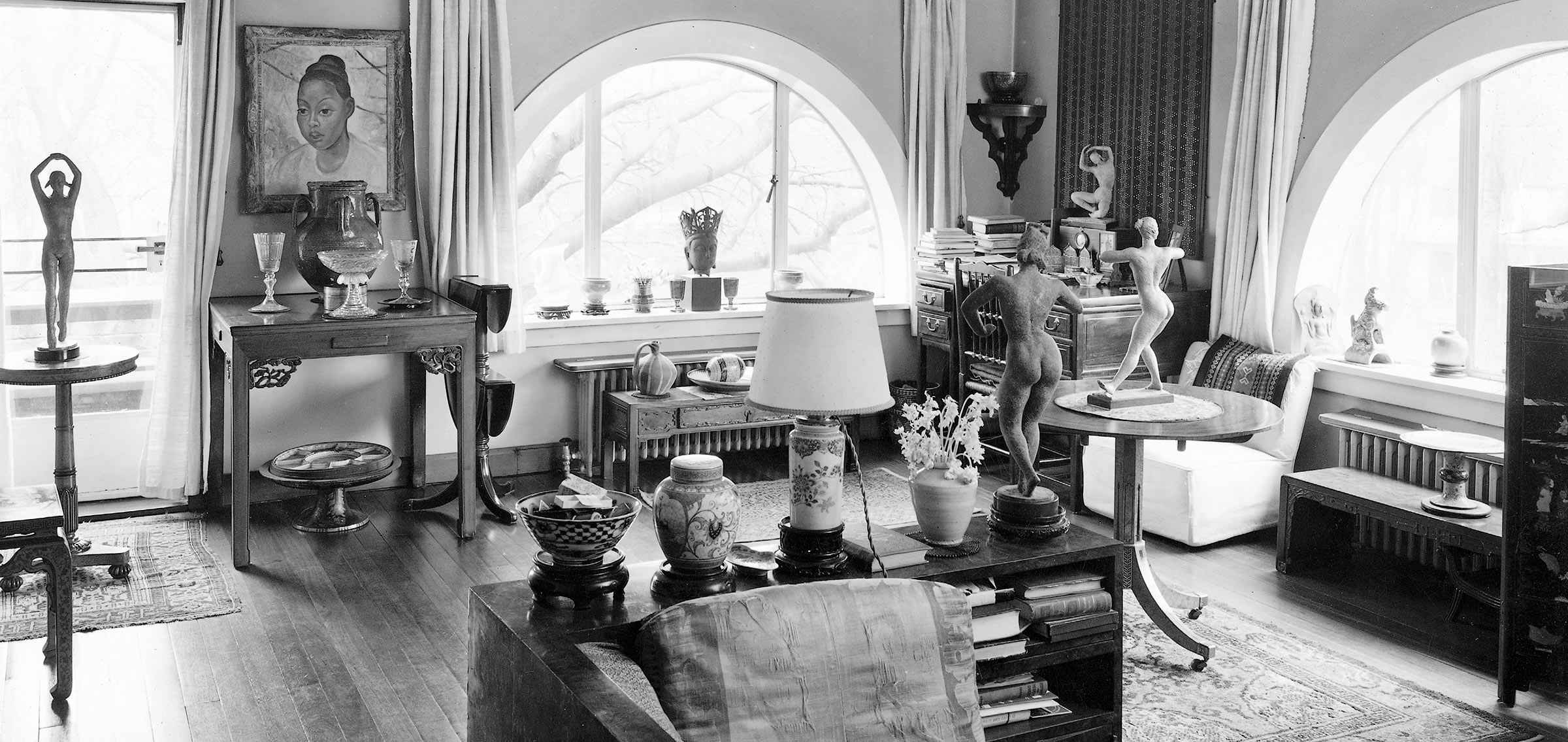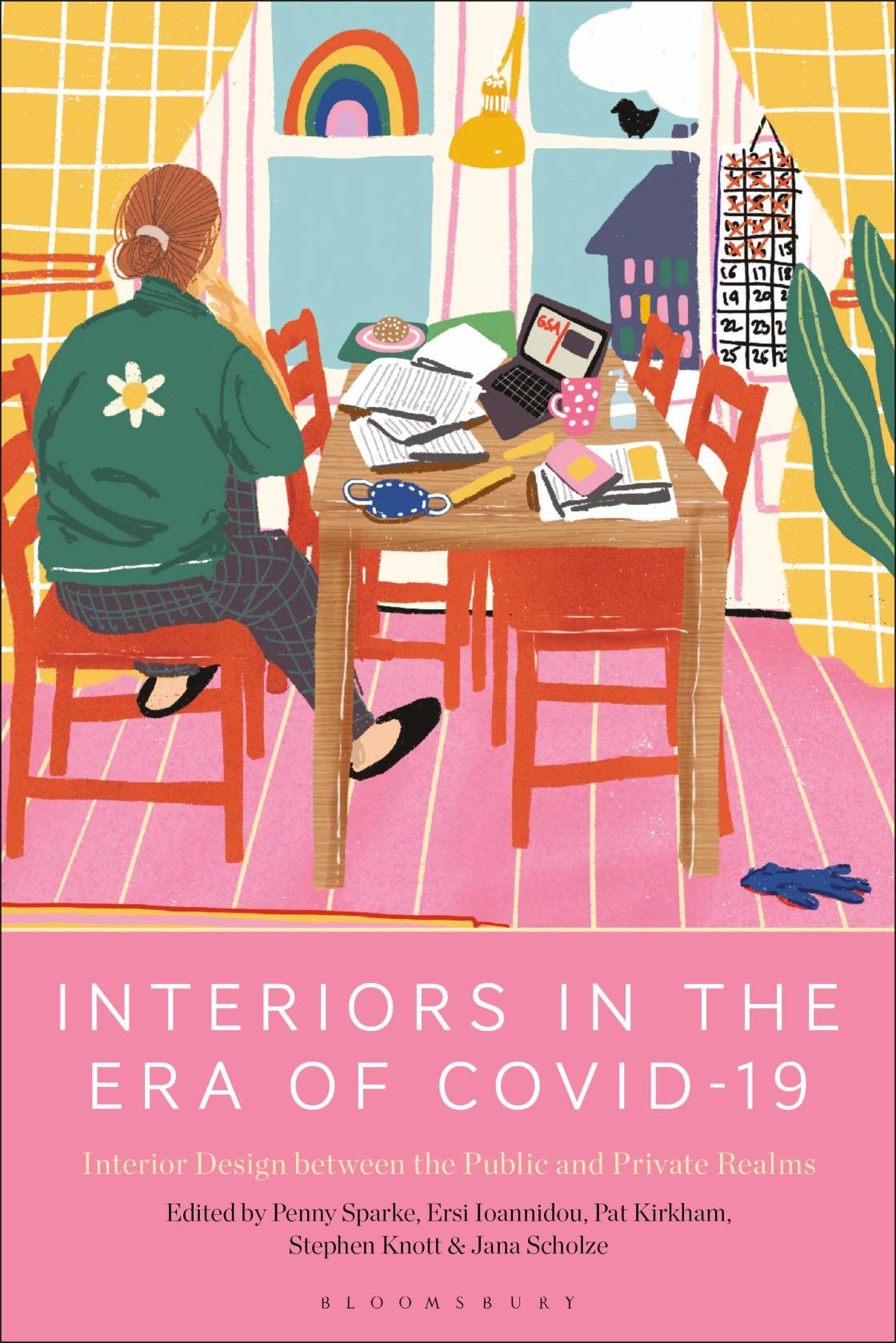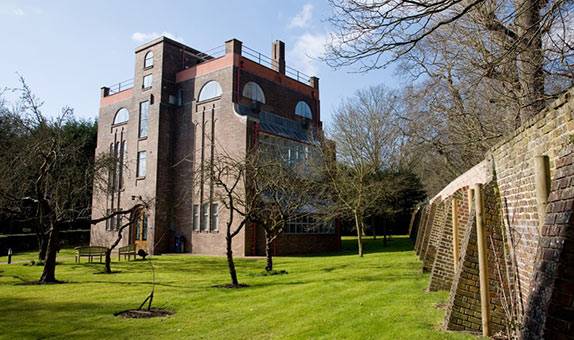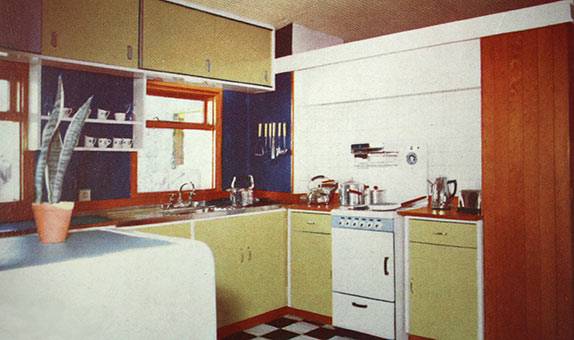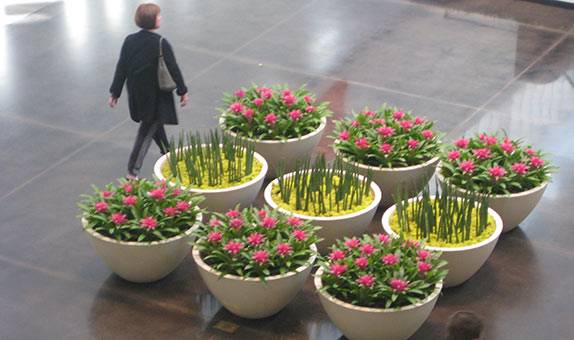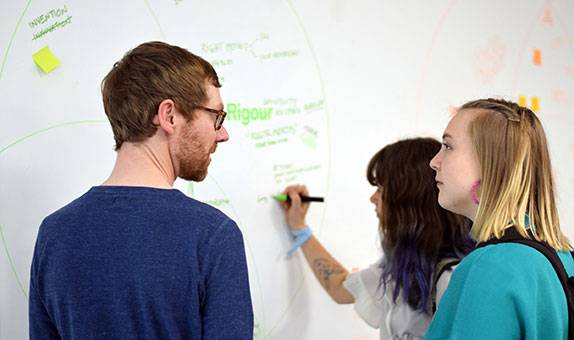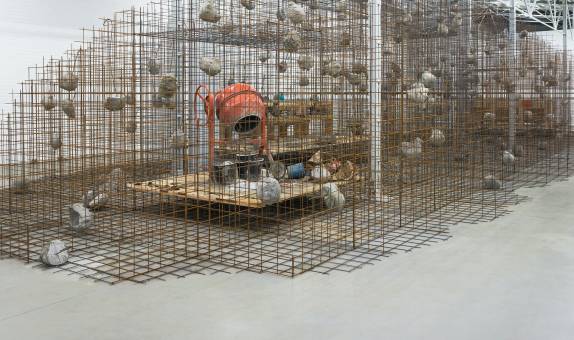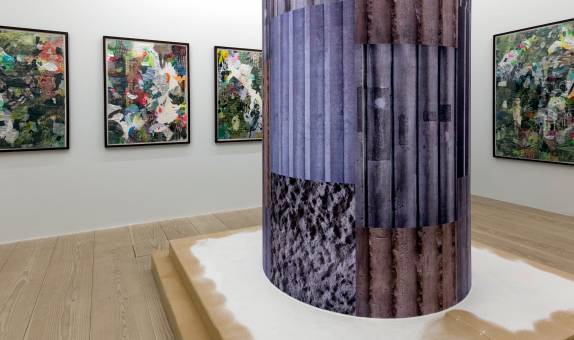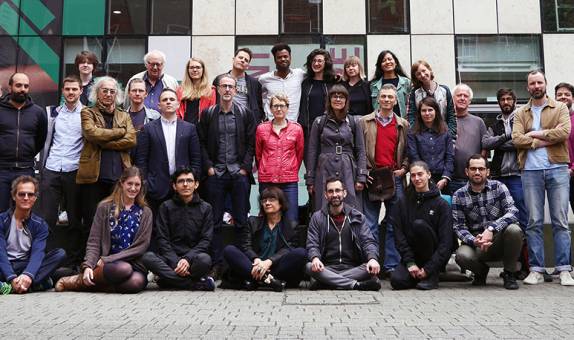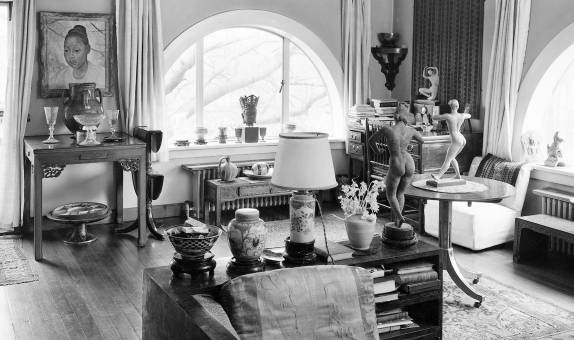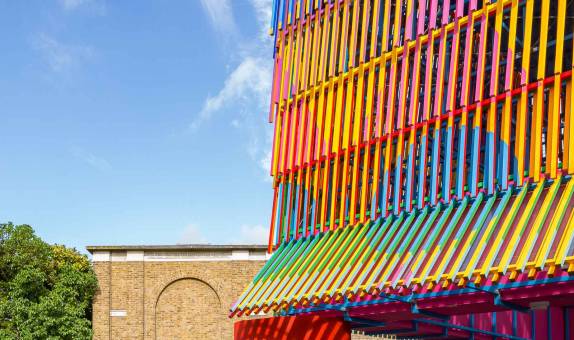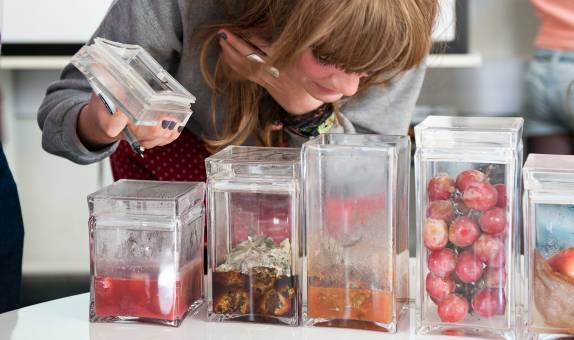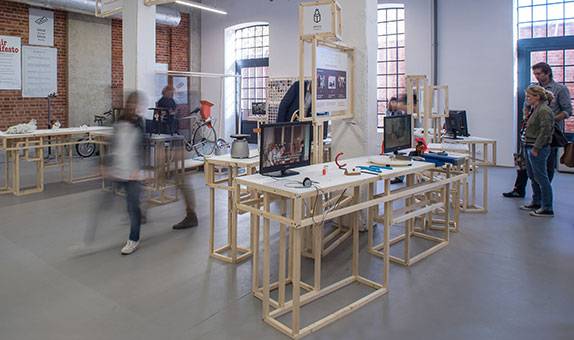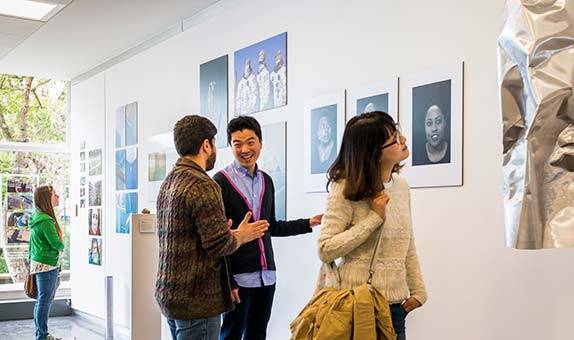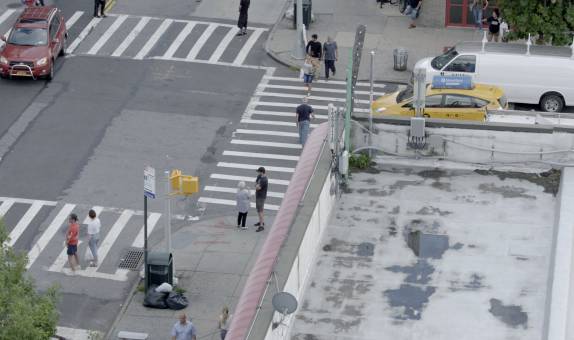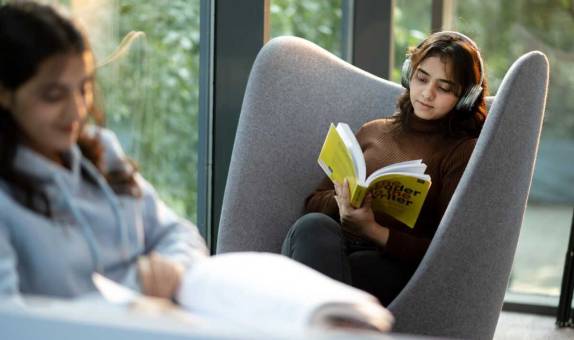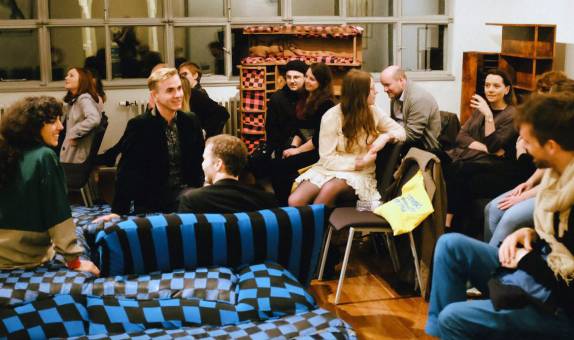Tuesday 9 May 2023, 10:00 – 17:00 UK time
Hosted by The Modern Interiors Research Centre, Kingston University London.
Exhibitions have long been studied by scholars in the fields of art, design, and architectural history and cultural studies. They have, for example, been seen as representations of national or global identities – as communicators of a range of ideologies, from political fascism to Cold War socialism and corporate capitalism and, most recently, as tools for undertaking and sharing research. They have long been understood as having a didactic and/or a commercial function. Very often, however, the focus has been more upon their contents and their narratives than on their design. Very seldom have they been considered as a specific type of constructed interior.
This conference addresses histories, theories, and practices of exhibitions as interiors in a wide range of settings. They could include examples in purpose-built exhibition halls, pavilions, museums, and galleries, or others which temporarily occupy pre-existing structures such as hotels, department stores, transport spaces, heritage sites or private houses. It welcomes papers which consider the whole interior of the exhibition, from the building, the part of a building, or the temporary enclosure in which it is set, to the navigation within it. It embraces research on the spatial, material, and virtual qualities of exhibitions, the sensorial and the performative, as well as the political, social, ecological, and educational. It will also explore the roles and experiences of figures including the exhibition designer, curator, programmer, and exhibition visitor. Exhibitions under review could range from the cultural to the commercial and engage with examples created in both institutional and non-institutional settings, by amateurs and professionals, and through interdisciplinary, collaborative and/or participatory practices.
This new approach towards exhibitions as constructed interiors will open the possibility of engaging with ideas discussed in relation to interiors in general, from interiority to the relationship between the private and the public realms. It will also establish exhibitions as a site for discussion of themes of contemporary relevance, such as decolonisation, gender politics and the climate emergency. Importantly, the conference will also interrogate the consequences of adopting this perspective for contemporary curatorial and exhibition design practices.
View the conference programme
Session 1: Exhibition spaces as interiors
- 10.20: Jose Vela Castillo (IE University – Segovia and Madrid, Spain)
Interior Architecture, Where the Desire (for Modernity) May Live
- 10.30: Katerina Štroblová (University of Ostrava, Czech Republic)
Heart of the City: Exhibition as Total Space
- 10.40: Lia Carreira (University of Southampton)
Exhibitions as Laboratories and the Office Work Stations of the 1990s
- 10.50: Trine Friis Sørensen (Aarhus University and Kunsthal Aarhus)
Negotiating the White Cube: Textile Interiors
- 11.00–11.30: Panel/Q & A
- 11.30–11.45: Break
Session 2: Exhibiting Interiors
- 11.45: Laura Ingianni Altmann (Art historian and curator, Munich, Germany)
The ‘Home and Technology' Exhibition in Munich, 1928
- 11.55: Kate Hill (University of Lincoln)
‘Genuine Oak Beams and Rafters': Historical Reconstructions in Museums,1930-1960
- 12.05: Cvetka Požar and Maja Vardjan (Museum of Architecture and Design, Ljubljana, Slovenia)
Model Apartments and New Culture of Living in Socialist Yugoslavia
- 12.15: Stefan Krämer (Ruhr-Universität Bochum)
Beyond the Period Room: Reframing the Interior as a Space for Diasporic Narratives
- 12.25: Ben Angwin (PhD candidate, Kingston University, London)
From ‘Ideal Home' to Modern Art Exhibition: Revisiting the Exhibited Interiors of the Omega Workshops
- 12.35: Ashley Paine (The University of Queensland, Australia)
A Window on the Museum: Reconstructing the Interiors of Frank Lloyd Wright
- 12.45–1.15: Panel/Q&A
- 1.15–2.15: Break
Session 3: Commercial interiors as exhibition spaces
- 2.15: Gina Leith (University of Edinburgh, Scotland)
Work-watching: Exhibition as a Re-presentation of Existing Distillery Interiors
- 2.25: Stephanie Dieckvoss (PhD candidate, Kingston University London)
The Hotel Room as Art fair Booth, as Interior, as Exhibition
- 2.35: Amy Graham (Sheffield Hallam University)
The Space of the Bus: Heritage Interpretation of the Urban Interior
- 2.45: Catriona Quinn (UNSW Sydney)
Interior Fantasy: Designing for Migrants in post-war Australia
- 2.55–3.25: Panel/Q&A
- 3.25 – 3.35: Break
Session 4: Residential interiors as exhibition spaces
- 3.35: Alejandro Campos Uribe (Department of Architecture, Technical University Delft)
The Interior, Exhibition of One's Self: On Architecture, Collecting, and the Everyday
- 3.45: Senem Yildirim (New York University)
A Gallery That Does Not Exist: On Furmany Lane Artist Squat and Exhibiting Soviet Art
- 3.55: Imogen Hart (Independent scholar)
Craft Exhibitions as Interiors in Inter-war Britain
- 4.05: Karen Shelby (City University of New York)
Domestic Interiors and Exhibition Installation: Jan Hoet's ‘Chambre D'Amis'
- 4.15: Hans-Christian Jensen (University of Southern Denmark, Kolding)
Tangible Advice: A Home show in the Periphery of Danish Design in 1953
- 4.25: Gina Hochstein/Andrew Douglas (The University of Auckland, New Zealand)
In the Shadow of the Picture Window: A consideration of the Domestic as Counter-Exhibition
- 4.35–5.00: Panel/Q&A
- 5.00: End
Session 1: Exhibition spaces as interiors
- 10.20 (Interior) Architecture, Where the Desire (for Modernity) May Live
In 1952 the Spanish architect José Luis Fernández del Amo was appointed director of the (National) Museum of Contemporary Art. He conceived the new institution as an open space in which contemporary art could be housed, shown and produced. Yet given the complex political situation of Francoist Spain, the effort ultimately failed. However, Del Amo was able to design and built the temporary seat for the Museum inside a covered patio of the existing 19th century National Library building. This way the Museum relied on the construction of both an interior and exterior civic space, a protected environment in which, at least temporarily, the desire for a new art (and a better society) could live.
Presented by Dr José Vela Castillo
- 10.30 Heart of the City: Exhibition as Total Space
The paper Heart of the City: Exhibition as Total Space focuses on the project of Rafani, Czech art collective. In one of their exhibitions, conceived as places for interaction between the viewer and the artist, they changed a gallery in the city centre into a temporary living area, inaccessible for ordinary visitors. The paper shows how it is possible to modify the /exhibition/ space and how, based on this modification, is possible to articulate current issues. It discusses the ways of approaching the gallery space and using it as a mirror of different social phenomena.
Presented by Dr Katerina Štroblová
- 10.40 Exhibitions as Laboratories and the Office Work Stations of the 1990s
The laboratory has been recurrently invoked within the Arts since the early twentieth century with figures such as Richard F. Bach in 1922 weaving the ties between art and industrial making under the rubric of the museum as a laboratory to convey the idea of a space for collaboration and knowledge-sharing, and Siegfried Giedion in 1929 calling for an "experimental laboratory" in every public institution as a department which would allow for the art of the present to be heard. This early laboratorisation of the museum has, since then, been extended to the particular space of the exhibition, in which the laboratory has taken many shapes and forms. This paper presents a relatively more recent approach to the exhibition as a lab motto through an analysis of the 1999 Laboratorium exhibition in Antwerp, Belgium. Laboratorium, curated by Hans Ulrich Obrist and Barbara Vanderlinden, aimed at exploring the idea of the laboratory, in all its diversity, as a "workplace" by inviting practitioners from different fields to establish a form of "place where people exchange ideas around an experimental set-up".
Presented by Lia Carreira
- 10.50 Negotiating the White Cube: Textile Interiors
This paper enquires into the significance of the textile-lined gallery walls at Kunsten Museum of Modern Art in Aalborg (DK) with special attention to the ear and the multidisciplinarity that the architecture of the museum affords. I will do so by piecing together an analysis that draws on the use of coarse textiles like hessian on gallery walls, the particularity of linen in dialogue with textile designer Anni Albers and finally the shortcomings of the white cube when it comes to hosting non-silent contemporary art practices. Based on this analysis, I argue that the textile-lined gallery walls take issue with the white cube and modernism in its purest form.
Presented by Trine Friis Sørensen
- 11.00-11.30 Panel/Q & A
- 11.30-11.45 BREAK
Session 2: Exhibiting Interiors
- 11.45 The ‘Home and Technology' Exhibition in Munich, 1928
Only one year after the highly acclaimed Stuttgart Werkbund exhibition Die Wohnung (The Dwelling), in 1927, the show Heim und Technik (Home and Technology) in Munich presented fully equipped model flats. In contrast to the lasting legacy of the Werkbund exhibitions, Munich's 1928 exhibition has been largely ignored by architectural research, despite being designed by notable architects of the period. The lecture analyses Home and Technology's multi-layered and participatory conceptual approach and its novel approach to displaying the apartments. The source base comprises vast archival material of correspondence and photographs that have never been evaluated.
Presented by Laura Ingianni Altmann
- 11.55 'Genuine Oak Beams and Rafters': Historical Reconstructions in Museums, 1930-1960
This paper examines the construction of kitchens, cooking hearths and firesides in British museums between 1920 and 1950, a period during which they were seen as dominating curators' ideas. It focuses on how installations, supervised by curators with little experience or expertise in the field, enacted compromises between the ‘real' stuff of the museum and the ‘illusion' of practices from international exhibitions. There was a clear development over time from displays which were simply indicative of historic interiors to those which were more fully mimetic, leading by 1950 to a desire to create full open-air museums.
Presented by Kate Hill
- 12.05 Model Apartments and New Culture of Living in Socialist Yugoslavia
After the Second World War, the newly established Socialist Federal Republic of Yugoslavia based its visions of everyday life on collective housing, industrial production and social equality. All three areas have evolved simultaneously, and in parallel with the development of a specific model of socialism defined by the newly-minted system of self-management. In the 1950s the new culture of living became one of the central architectural and social issues related to the modernisation and urbanisation of the country. This ambition was promoted in the large fairs, with exhibitions and symposia such as Housing for Our Conditions (Ljubljana, 1956) and Family and the Household (Zagreb, 1958), which were organised as major state efforts to raise the awareness of modern lifestyle in a predominantly rural country.
Presented by Cvetka Požar and Maja Vardjan
- 12.15 Beyond the Period Room: Reframing the Interior as a Space for Diasporic Narratives
Can the period room be a device for postcolonial critique? This paper focuses on two contemporary installations in London and New York that transform this display into a site for marginalized legacies. By creating spaces for a collaborative engagement with material heritage and personal memories, the two works discussed here not only challenge the display of the ‘historic interior', but also the outdated concept of a homogeneous culture. I will analyse how they open the room for diasporic communities and narratives of cultural hybridity beyond the Western canon – and thereby establish a new era of the period room display.
Presented by Stefan Krämer
- 12.25 From ‘Ideal Home' to Modern Art Exhibition: Revisiting the Exhibited Interiors of the Omega Workshops
This paper revisits a little explored exhibited interior by the Omega Workshops, a Post-Impressionist inspired sitting room produced for the Daily Mail's Ideal Home exhibition in 1913. It considers the promotional nature of such public exhibition scenarios and the varied reception of the Omega's exhibited interior. It then explores the reasons behind the Daily Mail's invitation to the Omega, as well as the possible reasons behind the Omega's accepting of it. It concludes by considering how such public exhibition scenarios differed from smaller and more specialist modern art exhibitions, why the Omega may have sought to synthesise these contrasting exhibition settings, and lastly, why afterwards the Omega preferred to exhibit interiors to more supportive and exclusive audiences.
Presented by Ben Angwin
- 12.35 A Window on the Museum: Reconstructing the Interiors of Frank Lloyd Wright
If period rooms are most often associated with the nineteenth century exhibition of interiors, then the appearance of numerous rooms since the mid-1970s featuring the work of American architect, Frank Lloyd Wright, might seem anachronistic. Their emergence is also surprising given that, by this time, periods rooms had largely fallen out of favour with museums and were widely criticised as inauthentic constructions that distorted material history. But rather than dismiss them as museological anachronisms, this paper takes a close look at Wright's exhibited interiors, with a particular focus on their windows, to redress Wright's period rooms as experiments in preservation, design, and display.
Presented by Ashley Paine
- 12.45-1.15 Panel/Q&A
- 1.15-2.15 LUNCH
Session 3: Commercial interiors as exhibition spaces
- 2.15 Work-watching: Exhibition as a Re-presentation of Existing Distillery Interiors
This paper presents Visitor Centres in Scottish Whisky Distilleries, to interrogate spaces in which work-watching becomes a leisure pursuit. Here, global brand strategies merge with a local cast of characters to create unique experiential interiors. These modern interventions layered over live working interiors, challenge the notion of what it means to ‘exhibit', in contrast to a traditional exhibition as a remote representation of an abstract theme or place. This presentation sets a discourse for permanent environments re-presented as exhibitions; constructed as a second skin, not as change of use, but rather as a physical manifestation of a parallel activity.
Presented by Gina Leith
- 2.25 The Hotel Room as Art fair Booth, as Interior, as Exhibition
This presentation uses the Gramercy International Hotel Fair in New York (1994-1998) as a case study. It aims to understand how alternative models of spatial organisation in art fairs shaped the relationship between objects and space and thereby the visitors' perception. The novelty of the Gramercy fair consisted not only in using a hotel as an art fair venue but in turning hotel rooms into factual art fair ‘booths'. In most cases artworks were added to the existing interior of the rooms, creating intimate, domestic exhibition spaces, which included seating areas, bathrooms, and the bed. Multiple hotel rooms transformed briefly into temporary sites of exhibition while maintaining their function as hotel rooms. This paper will focus on one aspect of the hotel room as exhibition space: the impact the use of an existing hotel room interior has on the kind of art exhibited, the different modes of interaction both the space and the artwork demand, and how the visitor experience was shaped by these encounters.
Presented by Stephanie Dieckvoss
- 2.35 The Space of the Bus: Heritage Interpretation of the Urban Interior
The bus interior is a commercial-quasi-public space which provides the conditions for passengers' ‘interior work' of reflexivity, observational cruising and remembering. This paper focuses on the presentation of the Shillibeer Omnibus in the London Transport Museum. The artefact on display is a 100-year-old replica of a 160-year-old form, carrying mannequin passengers and bearing the traces of visitor interactions in foot- and fingerprints. A detailed examination of it as both an object and symbolic referent facilitates a discussion about the bus-as-thing: navigating boundaries between the past and the present, the artefact and the visitor, and the reproduced and the real.
Presented by Amy Graham
- 2.45 Interior Fantasy: Designing for Migrants in post-war Australia
In the 1960s and 1970s, the Society of Interior Designers of Australia staged a series of public exhibitions in Sydney department stores to promote the decorating profession and the value of design. Thousands of visitors navigated displays showing a spectrum of interior styles in fully realized rooms by top decorators, themed around fantasy lifestyles of celebrities. Sydney firm Decor Associates' extravagant, glamorous room settings attracted gushing media coverage and with it, a niche market of European migrant clients, whose histories depart from conventional narratives of the émigré in Australia as emissaries of orthodox modernism.
Focusing on three exhibition rooms constructed by Decor Associates from 1962 to 1975 and based on substantial unpublished histories of ensuing private commissions, this paper explores the relationship between interior design and postwar migrant clients. Q&A: Did the decorating profession change because of these department store exhibitions promoting fantasy lifestyles? Did the exhibitions promote the value of modern design and thus the profession of interior designer?
Presented by Catriona Quinn
- 2.55-3.25 Panel/Q&A
- 3.25 – 3.35 BREAK
Session 4: Residential interiors as exhibition spaces
- 3.35 The Interior, Exhibition of One's Self: On Architecture, Collecting, and the Everyday
While Aldo and Hannie van Eyck (1919-1999/2018) have been mostly credited for their building designs, they also designed many exhibitions throughout their lives. Nonetheless, little is known that the Van Eycks inhabited an exhibition themselves, a concealed house in the Netherlands, where the Van Eycks played the role of the designer, the curator, the director, the visitor; inhabiting the space together with their artworks. This presentation uses this interior as a key to unpack the ways domesticity, exhibition design, global travels and art collecting are intersecting fields (intersecting "at home"), and how they sustained the Van Eycks' profound revision of Modern Architecture.
Presented by Alejandro Campos
- 3.45 A Gallery That Does Not Exist: On Furmany Lane Artist Squat and Exhibiting Soviet Art Underground
The presentation focuses on a very particular case of re-appropriation of the domestic space as a zone of artistic production/exhibition and overall, artistic expression during Glasnost and Perestroika by an underground artist group of late Soviet Moscow: taking over the Furmany Lane residential blocks by Moscow Nonconformist circle in 1987. While tracing the history of Furmany Lane squat as an artist-run space, the presentation discusses the modes of collaborative production and collective curation as well as exhibition where the artists took the role of critics, curators and documenters of themselves in the case of Moscow Nonconformist circle.
Presented by Senem Yildirim
- 3.55 Craft Exhibitions as Interiors in Inter-war Britain
For craft societies in interwar Britain, exhibitions served the purposes of exposure, promotion, critique and community building. Craftspeople and curators, many of them women, developed exhibiting strategies that used the model of the domestic interior to embrace the functional characteristics of objects and evoke the rituals of domestic space. Examining the practices of the Red Rose Guild (Manchester) and the Little Gallery (London), the paper explores how these groups experimented with the exhibition as interior to shape their identities as craft organisations.
Presented by Imogen Hart
- 4.05 "Domestic Interiors and Exhibition Installation: Jan Hoet's Chambres d'amis"
Throughout his career, Flemish curator Jan Hoet's goal was to open up new ways of engaging with both objects and space. This paper examines Hoet's iconic "Chambres d'amis," which blurred the boundary between interior and exterior/home and street, indoors and outdoors/interior rooms and patios, private and public/home and public life. For "Chambres d'amis," over fifty artists were asked to re-create and adapt pieces in their signature style for the site-specificity of fifty private houses in Ghent. As a result, the artworks were removed from any sense of a framing device that defines objects as "art" and, perhaps, created a shift in the very definition and function of art. In this paper, I explore the ways the removal of any sense of a traditional frame served to de-fetishize the artwork while, simultaneously and perhaps unconsciously, creating an installation and creating the impression of a museum period-room. Rather than function as an object of contemplation, the art becomes wholly integrated into the private life of a family.
Presented by Karen Shelby
- 4.15 Tangible advice – a home show in the periphery of Danish Design in 1953
This paper examines a home show in the provincial town of Odense where four fully furnished flats were open for the public in a newly constructed high-rise building. The event was praised by critics for the high degree of realism in educating the public about the blessings of modern furnishing. However, the realisation of such extensive tangible advice also entailed more pragmatism than usual. This enables a more nuanced interpretation of the alleged high culture of Danish dwelling that was promoted worldwide as Danish Design in this period.
Presented by Hans-Christian Jensen
- 4.25 In the Shadow of the Picture Window: A consideration of the Domestic as Counter-Exhibition
Exhibition entails framing. This paper explores the complex articulation of looking, displaying and holding up found in certain modernist houses in Tamaki Makaurau Auckland, the most populous city of Aotearoa New Zealand. The paper investigates the complex constellation of looking and displaying, accruing with the picture window common to these interiors. Cognizant of Beatriz Colomina's[1] articulation of a publishing of the private in modernist domestic interiors more generally, the paper rethinks what privacy and publicity entailed for a range of female creative practitioners living in modernist houses in Titirangi during the 1950s-1960s. As artists, writers, fabric designers, potters, weavers, musicians and jewellers, writers and painters, those women were instrumental in crafting and exhibiting an émigré outlook in an otherwise conformist suburban milieu common in Auckland at the time. Working with the picture window as a key organizing element of these houses, we explore how such windows frame, not just an outside vista, but also a renovation of the prevailing body politic, one reconstructing gender identities and senses of belonging.
Presented by Gina Hochstein and Andrew Douglas
- 4.35-5.00 Panel/Q&A
- 5.00 End of online conference
[1] Colomina, Beatriz. "Sexuality & Space". New York, N.Y.: Princeton Architectural Press, 1992.
Session 1: Exhibition spaces as interiors
- 10.20 Jose Vela Castillo (IE University – Segovia and Madrid, Spain)
Dr José Vela Castillo is an architect, educator and historian based in Madrid. He is Assistant Professor at IE School of Architecture and Design (Segovia and Madrid, Spain), where he teaches courses on Global Architectural History and Design Studio. His recent historical research focused on post-war modern Spanish architecture, with special emphasis on the architecture of the US military bases built in Spain in the 1950s, its infrastructural dimension and its wide political and cultural impact in the 'free world'. On a wider theoretical and philosophical context, Vela Castillo is focusing on the redefinition of the relations between fiction, narrative and meaning in the writing of history of architecture, and its critical consequences for architectural scholarship.
Dr José Vela Castillo will be presenting: (Interior) Architecture, Where the Desire (for Modernity) May Live
- 10.30 Katerina Štroblová (University of Ostrava, Czech Republic)
Dr Katerina Štroblová is active in the field of contemporary art. She works as a Senior Lecturer in Department of Theory and History of Fine Arts, Faculty of Fine Arts at University of Ostrava (CZ). In her research, she focuses on contemporary art practice of Central Europe. Based in Prague, she is also a freelance art reviewer and writer. Since 2010, she has been running an independent art space and studio - Luxfer Gallery in Ceská Skalice (CZ). Besides curating various projects here, she organised several individual and group exhibition events both in Czechia and abroad.
Dr Katerina Štroblová will be presenting Heart of the City: Exhibition as Total Space
- 10.40 Lia Carreira (University of Southampton)
Lia Carreira is currently a PhD candidate at the University of Southampton, Winchester School of Art (UK), where she develops research on the relationship between the laboratory and the exhibition space. Her past and present research focuses on the history of exhibitions and curatorial practices, with a critical view on contemporary discourses and methods.
Lia Carreira will be presenting Exhibitions as Laboratories and the Office Work Stations of the 1990s.
- 10.50 Trine Friis Sørensen (Aarhus University and Kunsthal Aarhus)
Trine Friis Sørensen is a curator, educator and New Carlsberg Foundation postdoc fellow at Kunsthal Aarhus and Department of Art History, Aesthetics & Culture and Museology at Aarhus University (DK). Her research focuses on institutional structures and curatorial methods as art institutions become increasingly multi- and interdisciplinary. Recent curatorial research projects include The Timeshare Project (2017) and Host (2019-20) by Céline Condorelli at Kunsthal Aarhus. She has published on topics such as commissioning, education and archives including works by Kajsa Dahlberg and Olof Olsson. Since 2018, she has been the programme coordinator of MA in Curating at Aarhus University.
Trine Friis Sørensen will be presenting: Negotiating the White Cube: Textile Interiors
- 11.00-11.30 Panel/Q & A
- 11.30-11.45 BREAK
Session 2: Exhibiting Interiors
- 11.45 Laura Ingianni Altmann (Art historian and curator, Munich, Germany)
Laura Ingianni Altmann is an art historian, she studied in Munich and Milan, and holds a PhD in the History of Architecture and curatorial studies from Technical University Munich (TUM). Her dissertation, "Government Architect in Germany. The woman architect Hanna Löv (1901-1995)", was published in 2021 by birkhäuser, Basel. She has taught at the Ludwigs-Maximilans University Munich, TUM, and is currently adjunct lecturer at Nuremberg Tech. She was curatorial fellow at Kunsthalle Munich and research associate at TUM. In summer 2022 she received a Minerva Short Term research for Israel. Since Oct. 2020 she has been working on a joint German-Israeli research project with Sigal Davidi on the life and work of Erna Meyer (1890-1975).
Laura Ingianni Altmann will be presenting The 'Home and Technology' Exhibition in Munich, 1928
- 11.55 Kate Hill (University of Lincoln)
Kate Hill is Associate Professor of History at the University of Lincoln, and works on the history of museums, heritage and collecting between 1850 and 1950. She has published on Victorian civic museums, women, masculinity, gender and museums, and historical reconstructions at 19th-century exhibitions. She is co-editor of the Museum History Journal. She is currently running the AHRC Network Making Museum Professionals with Dr Claire Wintle, and is working on a project on the development of folk and social history museums in the UK between about 1900 and 1970.
Kate Hill will be presenting: 'Genuine Oak Beams and Rafters': Historical Reconstructions in Museums, 1930-1960
- 12.05 Cvetka Požar and Maja Vardjan (Museum of Architecture and Design, Ljubljana, Slovenia)
Cvetka Požar is curator at the Museum of Architecture and Design (MAO) with a Ph.D. in development and theory of design, researches design, in particular visual communications. She is the author of the exhibition and book The Century of the Poster: Slovenian Poster Design in the 20th Century (2015) and (co)curator of numerous exhibitions, including Jože Brumen: Modernist Designer and Art Connoisseur (2021), The World Inside: Designing Modern Interiors, 1930–Today (2021), Made in: Crafts – Design Narratives (2020), Art for Everyday Life: Modernist Glass Design in Slovenia (2017), BIO 50: 3, 2, 1, ... TEST (2014), and Iskra: Non-Aligned Design 1946–1990 (2009).
Maja Vardjan, architect and curator at MAO, researches Slovenian architecture and design production of the 20th century and contemporary creative practices. She has taken part in the preparation of numerous publications and exhibitions, including The World Inside: Designing Modern Interiors, 1930–Today (2021), Made in: Crafts – Design Narratives (2020), Stanko Kristl: Humanity and Space (2018), Saša J. Mächtig: Systems, Structures, Strategies (2015), BIO 50: 3, 2, 1, ... TEST (2014). She was the co-curator of biennial of design BIO 26: Faraway, so Close (2017), which won the ICOM Slovenia award.
Cvetka Požar and Maja Vardjan will be presenting: Model Apartments and New Culture of Living in Socialist Yugoslavia
- 12.15 Stefan Krämer (Ruhr-Universität Bochum)
Stefan Krämer is doctoral candidate at the department of art history at Ruhr-Universität Bochum, Germany. From 2018-22 he was research associate in the project ‘Period Rooms. Between Exhibition Space and Living Room Negotiating Past and Present', funded by the German Research Foundation (DFG). He works on contemporary art and the practices of knowledge production in museums. In his dissertation, he examines current artistic and curatorial strategies of reframing the period room.
Stefan Krämer will be presenting: Beyond the Period Room: Reframing the Interior as a Space for Diasporic Narratives
- 12.25 Ben Angwin (PhD candidate, Kingston University, London)
Ben Angwin is a Ph.D. candidate at Kingston University, London. His thesis, titled Repositioning the Omega Workshops: Modern Patrons and Modern Markets, presents new research on the Omega's commercial activities, its collaborations with modern British theatre, and its complex relationships with wealthy female patrons. On the subject of the Omega, Ben has published in peer-reviewed journals Interiors and the Charleston Press. In 2018 he co-curated the exhibition Mantelpiece Modernism: The Omega Workshops, Bloomsbury, and Gordine at Dorich House Museum, London. More recently, he has contributed to curatorial discussions with the Courtauld Gallery for new displays of its Omega and Bloomsbury collections.
Ben Angwin will be presenting: From ‘Ideal Home' to Modern Art Exhibition: Revisiting the Exhibited Interiors of the Omega Workshops
- 12.35 Ashley Paine (The University of Queensland, Australia)
Ashley Paine is a Senior Lecturer in Architecture and Director of the ATCH (Architecture Theory Criticism History) Research Centre at the University of Queensland. His current research examines buildings as objects of exhibition, preservation and reconstruction in the museum, with a particular interest in the work of Frank Lloyd Wright. His books include Valuing Architecture: Heritage and the Economics of Culture (2020) and Trading between Architecture and Art: Strategies and Practices of Exchange (2019). Paine is also a practising architect, and co-founder of PHAB Architects: a Brisbane-based studio focused on public projects, exhibition design, residential and heritage works.
Ashley Paine will be presenting: A Window on the Museum: Reconstructing the Interiors of Frank Lloyd Wright
- 12.45-1.15 Panel/Q&A
- 1.15-2.15 LUNCH
Session 3: Commercial interiors as exhibition spaces
- 2.15 Gina Leith (University of Edinburgh, Scotland)
Gina Leith is an Interior Designer and educator currently teaching at Edinburgh College of Art. Design and research interests include scale and materiality: narrative environments: brand: and design process. In addition to her academic career Gina has extensive commercial experience practising Interior Design across a variety of sectors including the drinks and leisure industry, brand homes and visitor experiences.
Gina Leith will be presenting: Work-watching: Exhibition as a Re-presentation of Existing Distillery Interiors
- 2.25 Stephanie Dieckvoss (PhD candidate, Kingston University, London)
Stephanie is an Associate Lecturer on BA Culture, Criticism and Curation at Central Saint Martins, London, UK, and she regularly teaches on the business of the Art Market for IESA, London, as well as giving regular talks and keynote speeches. She has extensive experience in cultural management in the public and private sector, with over 15-year experience in commercial art galleries and art fairs. Her research areas include art and conflict in the 19th – 21st centuries, contemporary art markets, art and globalisation, private museums, and art schools as institutions.
Stephanie Dieckvoss will be presenting: The Hotel Room as Art fair Booth, as Interior, as Exhibition
- 2.35 Amy Graham (Sheffield Hallam University)
Amy Graham has recently completed her AHRC funded PhD at Sheffield Hallam University entitled ‘Bus Enthusiasm as Heritage Practice: Investigating Critical Approaches to Heritage Research'. The study worked with participants at London Transport Museum, on London's now cancelled heritage bus service (the 15H) and in their homes; it explores practices of collection, conservation, and communication across these sites and in relation to the significance of everyday bus passengering as ‘time consciousness'. Amy previously worked in heritage management as Kingston's Local History Officer (2013-2017). She holds an MA in Heritage (Kingston University, 2013) and a BA in Architecture (Cambridge, 2010).
Amy Graham will be presenting: The Space of the Bus: Heritage Interpretation of the Urban Interior
- 2.45 Catriona Quinn (UNSW Sydney)
Catriona is a design historian and Research Assistant at UNSW Arts, Design and Architecture. Her 2021 PhD thesis, ‘The role of the client in Australian design history 1950-1970', aims to broaden our understanding of the modern interior beyond narrow aesthetic values, by examining the role of the client in the production of domestic interior commissions. Formerly she worked at Sydney Living Museums. She curated the 1993 exhibition Sydney Style: Marion Hall Best, Interior Designer, which broke new ground as the first retrospective on an Australian interior designer.
Catriona Quinn will be presenting: Interior Fantasy: Designing for Migrants in post-war Australia
- 2.55-3.25 Panel/Q&A
- 3.25 – 3.35 BREAK
Session 4: Residential interiors as exhibition spaces
- 3.35 Alejandro Campos Uribe (Department of Architecture, Technical University Delft)
Alejandro Campos is a Marie Sklodowska-Curie Fellow at the Department of Architecture, Delft University of Technology, where he received EU funding for the project Multiculturalism in the work of Aldo and Hannie van Eyck. Rethinking universalist notions in architecture. Alejandro specializes in Post-War Modern Architecture and the colonial dynamics behind its universalizing claims. His research and teaching interests focus on post-war European architecture, particularly the work of Aldo van Eyck. His PhD is an exploration of Van Eyck's own house as a document to unpack the architect's thinking. He has recently published an annotated Spanish translation of The Child, the City, and the Artist (2021).
Alejandro Campos will be presenting: The Interior, Exhibition of One's Self: On Architecture, Collecting, and the Everyday
- 3.45 Senem Yildirim (New York University)
Senem Yildirim is an architectural historian and an academic. She was granted a PhD in 2020 at Middle East Technical University, Graduate Program of History of Architecture. During her dissertation research, she worked as a Visiting Scholar at Columbia University-Harriman Institute in 2018 and is currently conducting research as a Post-Doctoral Fellow at New York University, Graduate School of Arts & Sciences, The Department of Russian and Slavic Studies with Prof. Boris Groys. Yildirim's research is structured around late-Soviet underground culture, unofficial art and artists' spaces in late-Soviet context as well as Soviet everyday life and Soviet domestic spaces. Her latest work "This Is How We Live": [In] Appropriate Rooms: Nonconformist Apartment Exhibitions and the Case of the Communal Apartment, 1982–1984", is published in the edited volume "Appropriated Interiors" by Routledge Press.
Senem Yildirim will be presenting: A Gallery That Does Not Exist: On Furmany Lane Artist Squat and Exhibiting Soviet Art Underground
- 3.55 Imogen Hart (Independent scholar)
Imogen Hart is the author of Arts and Crafts Objects and co-editor of Rethinking the Interior, c. 1867–1896: Aestheticism and Arts and Crafts, with Jason Edwards, and Sculpture and the Decorative in Britain and Europe, Seventeenth Century to Contemporary, with Claire Jones. Recent publications include two co-edited special issues of the Journal of Modern Craft on ‘Exhibiting Craft: Histories, Contexts, Practices' and ‘Disrupting Boundaries: The Politics of Craft Exhibitions'. After completing her PhD in History of Art at the University of York, she worked at the Yale Center for British Art and, most recently, the University of California, Berkeley.
Imogen Hart will be presenting: Craft Exhibitions as Interiors in Inter-war Britain
- 4.05 Karen Shelby (City University of New York)
Dr Karen Shelby is an Associate Professor of Art History at Baruch College, City College of New York. Her publications examine the visual culture of the Great War and the cultural politics of exhibition narratives of war in museums along the Western Front. Her current research addresses contemporary Belgian artists and innovative exhibition practice in Ghent. She is currently working on a book, Sint Jan/Jan Hoet. She is co-founder of Art History Teaching Resources (AHTR), a peer-populated platform for art history instructors and Art History Pedagogy and Practice (AHPP), a journal devoted to scholarship of teaching and learning in art history.
Karen Shelby will be presenting: "Domestic Interiors and Exhibition Installation: Jan Hoet's Chambres d'amis"
- 4.15 Hans-Christian Jensen (University of Southern Denmark, Kolding)
Associate Professor and Deputy Head of Department at Department of Media, Design, Education, and Cognition, University of Southern Denmark, Kolding. Teaches Design Studies, Design Culture and Design Management. Recent publication in English (co-authored with Professor Anders V. Munch) "Selling Time: Multiple Temporalities in the Promotion of Danish Design Classics", Journal of Design History, Vol. 35, Issue 1, 2022. pp. 53-69. Co-editor of Design Culture. Objects and Approaches, Bloomsbury 2019.
Hans-Christian Jensen will be presenting: Tangible advice – a home show in the periphery of Danish Design in 1953
- 4.25 Gina Hochstein/Andrew Douglas (The University of Auckland, New Zealand)
Gina Hochstein is a Lecturer at Unitec Te Pukenga and is currently completing her PhD by creative practice at the University of Auckland. Her PhD combines research and written scholarship with a creative project output investigating the complex intersection of craft practices and architecture that results in items of adornment on the female form for an exhibition. She is also a Professional Teaching Fellow at the University of Auckland supervising and examining thesis students. She is co-chair of Architecture + Women New Zealand and advocates for agency and equity for women in the architectural realm. She practiced architecture within the Heritage field and her research looks to modernism and the role of body politics in space.
Andrew Douglas is a senior lecturer in theory and design in the School of Architecture and Planning at the University of Auckland. He is an executive editor of Interstices: Journal of Architecture and Related Arts. He currently chairs the enigma: he aupiki Trust and is a trustee on the Greg Bowron Memorial Trust. He has practiced architecture in both Auckland and London and completed postgraduate studies at the University of Auckland and Goldsmiths, University of London. His research ranges across fields associated with urban and Greek philosophy and history, aspects of Continental philosophy—particularly the work of Gilles Deleuze and Felix Guattari—critical perspectives on socio-spatial practice, and gender and sexuality as these pertain to literature, cinema and the urban imaginary.
Gina Hochstein and Andrew Douglas will be presenting: In the Shadow of the Picture Window: A consideration of the Domestic as Counter-Exhibition
- 4.35-5.00 Panel/Q&A
- 5.00 End of online conference
